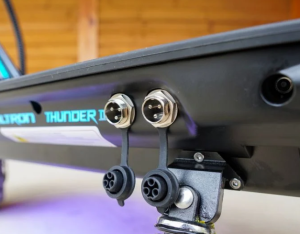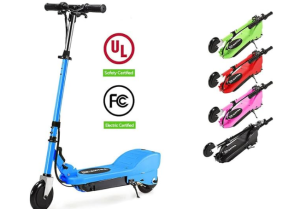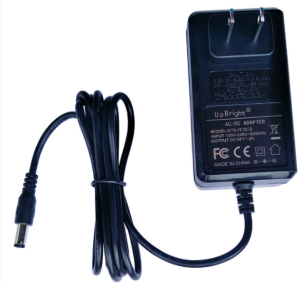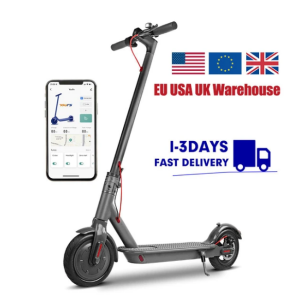Electric scooters primarily use Direct Current (DC) for efficient, reliable power.
Basics of Electric Power for Scooters
Electric scooters have become a staple in urban transportation, offering a blend of efficiency, eco-friendliness, and convenience. The core of these vehicles lies in their electric power systems, which can be powered by either Alternating Current (AC) or Direct Current (DC).
Understanding AC (Alternating Current)
AC is the type of electrical current that reverses its direction periodically. It’s the standard form of electricity supplied to homes and businesses, enabling the efficient transmission of power over long distances.
- Advantages: The ability to easily convert voltages using transformers makes AC ideal for the general power supply. AC motors, used less frequently in electric scooters, are known for their durability and capability in high power applications.
- Disadvantages: For electric scooters, AC systems can be more complex due to the need for a converter to transform AC from the grid into DC for battery storage.
Understanding DC (Direct Current)
DC represents electricity flowing in a single direction. It is the preferred type of power for most portable devices, including electric scooters, because it is stored easily in batteries and offers a stable voltage.
- Advantages: DC motors are simpler, more efficient for electric scooter applications, and provide a high torque at low speeds. This makes them ideal for the stop-and-go nature of urban mobility.
- Disadvantages: The transmission of DC over long distances is less efficient than AC, making it less suitable for the grid but perfect for localized use in vehicles like scooters.
Comparison of AC and DC
Here’s a detailed comparison of AC and DC in the context of electric scooters:
| Feature | AC (Alternating Current) | DC (Direct Current) |
|---|---|---|
| Efficiency | Lower in small, portable applications due to conversion losses. | Higher in electric scooters, as it directly powers the motor without conversion. |
| Cost | Generally higher due to the complexity of the motor and the need for conversion. | Lower, thanks to the simplicity of DC motors and control systems. |
| Design Complexity | More complex due to the need for power conversion. | Simpler, benefiting from direct battery power without the need for conversion. |
| Maintenance | May require more maintenance due to the presence of additional components like inverters. | Tends to have lower maintenance needs due to fewer moving parts and simpler electronics. |
| Lifespan | Variable, but often shorter in portable applications due to the conversion process and additional components. | Longer lifespan in electric scooters, attributed to the direct use of power and efficiency of DC motors. |
Electric scooters predominantly utilize DC power for its efficiency, simplicity, and cost-effectiveness. The direct supply of power from batteries to motors without the need for conversion makes DC the preferred choice for these portable vehicles.
Electric Scooters Power Systems
Electric scooters have surged in popularity as an efficient and eco-friendly urban transit method. Their power systems, particularly the types of motors and battery technologies employed, are pivotal to their performance and appeal.
Types of Motors Used in Electric Scooters
Brushed DC Motors: Initially prevalent in electric scooters, brushed DC motors are appreciated for their simplicity and cost-effectiveness. They necessitate more maintenance due to brush wear and generally exhibit lower efficiency compared to their brushless counterparts.
Brushless DC Motors (BLDC): BLDC motors stand out for their efficiency, longevity, and minimal maintenance needs. They operate without physical brushes, leading to less friction, better performance, and a higher efficiency rate. BLDC motors are now the standard in electric scooter design due to their superior power-to-weight ratio and reliability.
Battery Technologies for Electric Scooters
Lead-Acid Batteries: Once the go-to choice for electric scooters, lead-acid batteries offer a low upfront cost. However, their heavy weight, larger size, and shorter lifespan make them less ideal compared to more modern technologies.
Lithium-ion Batteries: Lithium-ion batteries have revolutionized power systems in electric scooters. They boast a higher energy density, lighter weight, and longer lifespan. Despite being more expensive initially, their efficiency and durability offer better value over time.
Nickel-Metal Hydride (NiMH): Less common in electric scooters, NiMH batteries provide a middle ground between lead-acid and lithium-ion batteries regarding cost, weight, and performance.
How Electric Scooters are Powered
Electric scooters are powered by electricity stored in their batteries, which is then converted into mechanical energy by the motor to propel the scooter forward. The efficiency and performance of an electric scooter heavily rely on the synergy between the battery’s capacity and the motor’s power output.
Energy Efficiency
The energy efficiency of an electric scooter is determined by how well it converts electrical energy from the battery into mechanical energy. BLDC motors, combined with lithium-ion batteries, offer the best efficiency, translating to longer rides per charge.
Operational Cost
The operational cost of an electric scooter is significantly lower than gasoline-powered vehicles, especially when considering the longevity and efficiency of lithium-ion batteries and BLDC motors.
Environmental Impact
Electric scooters have a minimal environmental footprint, especially when charged using renewable energy sources. The combination of efficient BLDC motors and rechargeable lithium-ion batteries contributes to a sustainable mode of transportation.
The advancement in motor technologies and battery systems has directly contributed to the improved performance, reliability, and appeal of electric scooters as a viable urban transportation option.
Advantages and Disadvantages of AC and DC in Electric Scooters
Electric scooters, a cornerstone of modern urban mobility, rely heavily on their power systems, which can be powered by either Alternating Current (AC) or Direct Current (DC). Each type of current offers distinct advantages and faces unique challenges in the context of electric scooters.
Benefits of Using DC in Electric Scooters
Direct Current (DC) is predominantly used in electric scooters due to its high efficiency and simplicity in design. DC motors are capable of delivering strong torque at low speeds, which is essential for the stop-and-go nature of city driving.
- High Energy Efficiency: DC motors efficiently convert electrical energy to mechanical power, offering longer rides on a single charge. This efficiency is crucial for maximizing the distance electric scooters can travel, making DC an ideal choice for battery-operated vehicles.
- Simplified Control Systems: DC power allows for simpler control systems, which not only reduces the overall cost but also minimizes the weight of the scooter, enhancing its portability.
Challenges with DC Power in Electric Scooters
Despite the advantages, DC-powered electric scooters face certain challenges:
- Battery Dependency: The performance and range of DC-powered scooters are heavily dependent on the battery’s capacity and health. As the battery degrades, so does the scooter’s performance and range.
- Limited Regenerative Braking Potential: While DC systems can support regenerative braking, the effectiveness of this feature is often less pronounced than in AC systems, potentially leading to less efficient energy recovery during braking.
Potential Uses of AC in Electric Scooters
While less common, AC power systems have potential applications in electric scooters, especially in models designed for longer distances or higher performance.
- Efficient Power at High Speeds: AC motors maintain efficiency across a wide range of speeds, making them suitable for electric scooters intended for varied speed ranges.
- Regenerative Braking Efficiency: AC systems excel in regenerative braking, converting more of the scooter’s kinetic energy back into electrical energy, which can then be reused. This feature can extend the range of electric scooters, making them more efficient in urban environments where stop-and-go driving is common.
DC motors are favored in electric scooters for their efficiency, ease of use, and cost-effectiveness, particularly suitable for the demands of urban commuting. The evolving technology and potential advantages of AC in specific scenarios, like enhanced regenerative braking and efficient operation at varied speeds, highlight a diverse future for electric scooter power systems. The choice between AC and DC power ultimately depends on the specific requirements of the scooter model, including its intended use, desired range, and cost considerations.
Maintenance and Troubleshooting
Electric scooters, while designed for durability and ease of use, require regular maintenance and occasional troubleshooting to maintain optimal performance. Understanding common electrical issues, battery maintenance, and general troubleshooting tips can significantly extend the life of your electric scooter.
Common Electrical Issues in Electric Scooters
Faulty Battery Connections: Loose or corroded connections can lead to power interruptions. Regular inspection and cleaning of battery terminals can prevent these issues.
Motor Problems: A malfunctioning motor can result from overheating, wear, or electrical faults. Symptoms include reduced acceleration or failure to start. Keeping the motor clean and free from debris is crucial for preventing damage.
Controller Failures: The controller is the brain of the electric scooter, managing power flow between the battery and motor. Signs of a failing controller include erratic scooter behavior or complete loss of power. Regular firmware updates can help prevent software-related issues.
Battery Maintenance and Care
Regular Charging: To maximize battery life, avoid letting the battery fully deplete before charging. Maintaining a charge level between 20% and 80% is ideal for lithium-ion batteries.
Storage Conditions: When not in use, store your scooter in a cool, dry place. Extreme temperatures can degrade the battery’s health. Avoiding prolonged exposure to high temperatures can prevent battery swelling and reduced lifespan.
Cleaning and Inspection: Keeping the battery and its connections clean and free from debris helps maintain optimal performance. Inspecting the battery for signs of wear or damage regularly can prevent unexpected failures.
Tips for Troubleshooting Electric Scooters
Check the Basics First: Ensure that the scooter is charged, the power switch is on, and there are no loose connections. Simple checks can often resolve common issues without the need for further troubleshooting.
Consult the Manual: For specific error codes or behaviors, refer to the scooter’s manual. Manufacturers often provide troubleshooting guides for common problems.
Software Updates: For models with connectivity features, ensure the scooter’s firmware is up to date. Software updates can fix known issues and improve performance.
Seek Professional Help: If the problem persists after basic troubleshooting, consulting a professional technician is recommended. Attempting complex repairs without the proper knowledge can cause further damage.
Maintaining an electric scooter involves regular care and occasional troubleshooting to address common issues. By following these maintenance tips and understanding how to troubleshoot basic problems, riders can ensure their scooters remain reliable and efficient over time.



